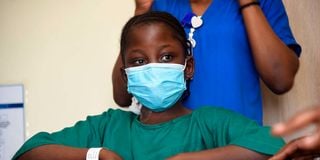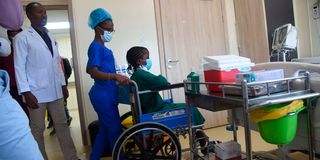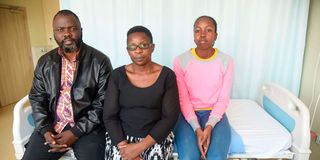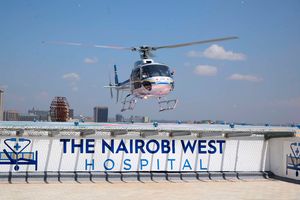New blood exchange technology puts a smile on sicklers’ faces

What you need to know:
- A number of Kenyan hospitals are adopting a nonsurgical procedure that empties a patient’s blood and replaces it with fresh one from a donor
- Sickle Cell Disease has contributed significantly to the mortality rate in children younger than five years, primarily because of late diagnosis, educational gaps among service providers and lack of access to appropriate treatment.
- In Kenya, it is estimated that 14,000 children are born with sickle cell every year.
As 11-year-old Hawi Ooko is wheeled into a treatment room at the Nairobi West Hospital, her infectious smile knows no bounds despite battling a disease that has ruined her life.
We learn from her mother Agnes Adhiambo that she was born with Sickle Cell Disease (SCD).
Dr Kibet Shikuku, a human pathology expert at the hospital, describes the procedure that Hawi is set to undergo - automated red blood cell exchange (RBC), also known as erythrocytapheresis.
It is a non-surgical treatment to remove a patient’s harmful red blood cells and replace them with safe red blood cells from a donor.
This means that if your child has SCD or another rare disorder where her red blood cells are abnormal, the doctor may recommend automated red blood cell exchange — rather than blood transfusions — as part of a long-term care management.

Hawi Oooko at Nairobi West Hospital.
Ms Mercy Cheptoo, a medical laboratory expert at the hospital, told Healthy Nation that regular blood transfusions can lead to an overload of iron in the blood of the patient, which can be toxic and potentially fatal.
However, an automated red blood cell exchange is not a cure but can help a patient avoid complications from the disorder and improve his or her health.
RBC exchange, according to the expert, is an accepted superior therapy to simple chronic transfusion due to minimal risk of iron overload and for secondary prevention of cerebrovascular accidents in selected patients with sickle cell anaemia.
“Can I watch cartoons?” A brave and resilient Hawi inquiries from her nurse, Ms Caroline Lusaria, as she lifts her off the wheelchair onto an automated comfy bed while a team of five others prepares all the material they need for the five-hour procedure.
“You can watch anything you like and if you don’t feel like sleeping, I can adjust your bed so that you sit up and talk to me, this is a painless procedure, “Ms Lusaria assures the little girl in a soft, sweet and warm whisper. She broadly smiles back.
Dr Kibet introduces Hawi’s parents to a smaller part of a huge printer-like machine he calls a centrifuge.
“So basically, a centrifuge is the machine separates the red blood cells from the other parts of the blood (white blood cells, plasma and platelets). The separated red blood cells are collected and then discarded while remaining blood components are mixed with healthy red blood cells from a blood donor and returned to your child,” he tells them.
“This is happening in other countries as well, many patients are benefiting but that has been slow in Kenya. This is better technology than just transfusing sicklers with blood continuously as continuous transfusions destroy them more.”
As Hawi’s parents look on, they disclose to Healthy Nation that the procedure will see them part with Sh100,000, only for the blood exchange.

Bonface Ogutu,Agnes Adhiambo and their daughter before witnessing her undergo Sickle Cell BMT allogenic therapy (blood exchange procedure) at Nairobi West hospital on January 11,2023.
“I am a proud mother to a sickler. When God blesses you with a child, expectations are more on the mother’s side,” Agnes starts off.
“It was not until she was two and a half years old that the sickle cell disease was detected, she would just be okay during the day but by evening she would be in so much pain and crying. We rushed her to Kenyatta National Hospital and after a series of endless tests, the doctors realised that she had SCD.”
She told Healthy Nation that the doctors would then embark on psychologically preparing her for what she was going to be dealing with from that moment onwards.
“They maintained the crisis and I was taught how to take care of the baby through diet, medication and check-ups. I had to prepare myself for one crisis after another and have been managing them using a drug called hydroxyurea, which treats sickle cells by helping prevent the formation of sickle-shaped red blood cells, Pen V and Folic acid,” she explains.
Stroke
As per Agnes, after they left KNH after a series of visits to the doctor, all would be well for some time until when Hawi was nine years old when a stroke showed up.
“At the age of nine she suffered a stroke. We went to the hospital and thanks to therapy she was fine until two years later when a second stroke, which was more severe, damaged her,” she narrates.
“The dosage was increased and so far we have done two CT scans apart from the physiotherapy and occupational therapy , which is being done to help her with the speech.”
Recently, little Hawi was subjected to a Doppler ultrasonography test, which is a noninvasive test that can be used to estimate the blood flow through your blood vessels by bouncing high-frequency sound waves (ultrasound) off circulating red blood cells.
The test uses sound waves to produce images, but can’t show blood flow.
“The doctors wanted to find out the speed of the blood in the brain and the report was not encouraging because the blood was flowing in her brain at a very high speed at more than 250 millilitres per minute while normal is around 170 millilitres per minute. They advised that we had to do something because she was prone to a third stroke,” her mother disclosed .
According to Dr Shikuku, globally, around three-quarters of all those affected with SCD live in sub-Saharan Africa, where an estimated 240,000 babies with SCD are born every year.
SCD is the most common of hemoglobinopathies (a group of disorders passed down through families (inherited) in which there is abnormal production or structure of the hemoglobin molecule) in Kenya.
“In the western part of the country, about 4.5 per cent of children are born with SCD, and 18 per cent with sickle cell trait,” the US National Library of Medicine observed in a 2019 study.
Mortality rate
The researchers further noted that SCD has contributed significantly to the mortality rate in children younger than five years, primarily because of late diagnosis, educational gaps among service providers and lack of access to appropriate treatment.
“In Kenya, it is estimated that 14,000 children are born with sickle cell every year,” Dr Shikuku said.
The United Kingdom’s National Health Service (NHS) explains that SCD, which is most seen in people of African and Caribbean descent, is caused by inheriting the sickle cell gene.
“It’s not caused by anything the parents did before or during the pregnancy and you cannot catch it from someone who has it.”
This means that to be born with sickle cell, a child has to inherit a copy of the sickle cell gene from both their parents and it usually happens when both are “carriers” of the sickle cell gene, also known as having the sickle cell trait.
“Or it can happen when one parent has sickle cell disease and the other is a carrier of it.”
According to the Us National Library of Medicine, an automated RB exchange is performed using an apheresis device.
Therapeutic apheresis, according to experts , is a treatment modality that processes whole blood through medical technologies for the purpose of separating it into components and removing identified pathological cellular or plasma components.
Paediatric therapeutic apheresis treatments includes plasma exchange, red cell exchange/depletion, stem cell collections, leukodepletion ( a process by which leukocytes are removed from donated blood and plasma exchange with a secondary plasma device).
There is also manual RBC exchange which is based on the drawing of blood (phlebotomy) and what is known as isovolemic replacement/hemodilution as the body responds to acute blood loss with four basic compensatory mechanisms.
Therefore, knowledge of these mechanisms is what allows physicians to adequately assess the need for blood transfusion.
The National Library of Medicine points out that compared to simple RBC transfusions, RBC exchange offers several advantages, such a lower risk for iron accumulation and efficient control of pathological erythrocyte populations (the systems controlling the number, size, and haemoglobin concentrations of populations of human red blood cells).
While pointing out that the most frequent indication for a red blood exchange is sickle cell disease, disadvantages, however, include the higher costs of the procedure, the increased use of donor red blood cells and the requirement of apheresis devices and trained hospital staff.
“The challenge that I can talk about as a mother to a sickler is that we lack government support especially when it comes to buying the drugs they depend on, going to the clinics because a sickler has to attend a haematology clinic at least once a month. I expect that when we go to government hospitals the cost has to come down or the government makes it free.
“The occupational and physiotherapies for sicklers who have already suffered from stroke need to be upgraded apart from the awareness among parents of sicklers because they suffer from a lot of stigma and don’t understand when the child gets jaundiced,” she says.
“Sicklers get tired and dehydrated, even the teachers handling them in school need awareness on how to handle them.”
She further discloses that she has been advised that a process like a bone marrow transplant can give them a second chance in life.
“How much is a bone marrow transplant in our country? Most people go to India for such procedures and when you ask them why they opted for the Asian country, they say that the Indian government has streamlined its healthcare system and made treatment and medication needed very affordable compared to our country, which I have seen the cost of such a procedure range from eight to 10 million shillings.
“This is a procedure (blood exchange) that is not only going to help sicklers but also people with other blood disorders like leukemia, diseases that are really killing our next generation,” Agnes urges.
She has some advice for young mothers who may be currently coming to terms with raising sicklers.
“The news can come in shock, accept it in a positive way, do not be in denial — you are not going to help the child if you are. Do research and learn more on SCD and how you need to manage it because when a crisis comes and mostly they show up late in the night, you need to know what to do, have it at your fingertips.”
Mr Boniface Ogutu, Hawi’s father, agrees with his wife.
“We are in a country where at some point in life you realise you have to be in a corner alone more so when you have to deal with such a disease. Look at HIV/Aids, which gets a lot of support from government and non-governmental organisations but for SCD we are usually alone.
“Not everyone will embrace you ,there are relatives and friends who will stop picking your calls because they know you have a long-term patient in your house and when they see you call they think you want to borrow money from them,” he reveals.
Boniface, like his wife, says the cost of maintaining and treating a sickler is very draining “because before you go for it, you have to go for the smaller tests like the Doppler test and other blood tests which are also very costly.”
Dr Kibet admits that the service they offer is not cheap but “we always look upon the government to supplement these costs especially through the National Hospital Insurance Fund (NHIF). These procedure costs around Sh100,000 – Sh150,000 on the higher side, just for a single procedure and you can do this three to four times in a year.”
He further addresses the endless bouts of pain that sicklers have to grapple with, which makes them opt for strong pain killers such as ketamine potentially risking addiction to the painkillers.
“Pain occurs when we have occlusion (the blockage or closing of a blood vessel or hollow organ), imagine you need blood to circulate in your eye and the unfortunately a ‘sickled cell’ blocks that vessel.
Potentially whatever is ahead of that blocked area starts to die and that is how pain sets in.”
They do a red blood cell exchange which takes away the source of occlusion or dilutes it to a level that the blood can comfortably flow.
“The patients are now pain-free for three or four months after which they can come in for another session of the same procedure.”





